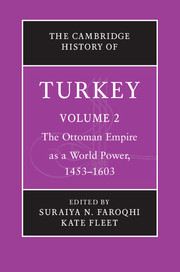Book contents
- Frontmatter
- Contents
- List of Illustrations
- List of Maps
- List of Contributors
- Chronology
- A note on transliteration
- Maps
- 1 Introduction
- Part I An Expanding Empire
- 2 The Ottomans, 1451–1603
- 3 Ottoman expansion in Europe, ca. 1453–1606
- 4 Ottoman expansion in the East
- 5 Ottoman expansion in the Mediterranean
- 6 Ottoman expansion in the Red Sea
- Part II Government, Economic Life and Society
- Part III Culture and the Arts
- Glossary
- Bibliography
- Index
- References
4 - Ottoman expansion in the East
from Part I - An Expanding Empire
Published online by Cambridge University Press: 05 July 2013
- Frontmatter
- Contents
- List of Illustrations
- List of Maps
- List of Contributors
- Chronology
- A note on transliteration
- Maps
- 1 Introduction
- Part I An Expanding Empire
- 2 The Ottomans, 1451–1603
- 3 Ottoman expansion in Europe, ca. 1453–1606
- 4 Ottoman expansion in the East
- 5 Ottoman expansion in the Mediterranean
- 6 Ottoman expansion in the Red Sea
- Part II Government, Economic Life and Society
- Part III Culture and the Arts
- Glossary
- Bibliography
- Index
- References
Summary
In contrast to the lands to the west, what surrounded the Ottoman state to the north, south and east were political structures which had the same religious, ethnic and/or cultural roots. Thus eastward expansion was not for the Ottomans merely a territorial or economic matter but was, more importantly, a struggle to establish and strengthen their own existence and legitimacy.
Expansion and control in Anatolia
Once he became master of Istanbul, Mehmed II turned his eyes to the prosperous regions of Anatolia, whose production and wealth were described by his contemporary Tursun Bey as beyond calculation. Motivated by the need to ensure the security of his newly conquered capital and the desire to control the trade routes, as well as other economic resources of the region, Mehmed’s initial target was the Black Sea coast, and in 1460 he attacked the strongly fortified Genoese colony of Amasra. Surprised, according to Aşıkpaşazade, that neither his father nor grandfather had taken it before, for the town was a refuge for runaway slaves and a centre for piracy which caused much damage to the surrounding population, he laid siege to it by land and sea. Realising that if they were to resist, the Ottomans would “enslave our wives and daughters, possess them, crumble our arrows in their hands, flatten our bows, cut off our heads with our own swords, and hang their own swords round our necks”, the Genoese acknowledged the wisdom of handing over the castle before any of this happened to them.
- Type
- Chapter
- Information
- The Cambridge History of Turkey , pp. 74 - 140Publisher: Cambridge University PressPrint publication year: 2012
References
- 2
- Cited by



